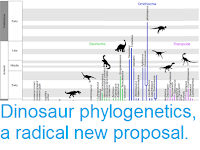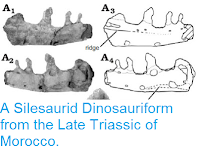The axis is the second cervical vertebra, forming the first cervical vertebra, the atlas, which enables movement of the head relative to the neck, and therefore the rest of the body. Examining this bone enables palaeontologists to asses the posture of extinct animals, making it a very useful piece of the anatomy when studying groups going through periods of rapid diversification and adaption. However, as with any other part of the anatomy, this bone is not always available for study, and is under-represented in the fossil record of many key groups. One such group is the early Dinosaurs, a group which during the Middle-to-Late Triassic diversified from a small Dinosauromorph ancestor into the strikingly different Theropods, Sauropods, and Ornithischians.
In a paper published in the journal Acta Palaeontological Polonica on 12 July 2017, Rodrigo Müller of the Programa de Pós-Graduação em Biodiversidade Animal at the Universidade Federal de Santa Maria, Flávio Pretto of the Centro de Apoio à Pesquisa Paleontológica da Quarta Colônia at the Universidade Federal de Santa Maria, Micheli Stefanello and Eduardo Silva-Neves, also of the Programa de Pós-Graduação em Biodiversidade Animal at the Universidade Federal de Santa Maria, and Sérgio Dias da Silva, also of the Centro de Apoio à Pesquisa da Quarta Colônia at the Universidade Federal de Santa Maria, describe a nearly complete Dinosaur axis bone from the early Late Triassic Buriol Outcrop of the Candelária Sequence in Rio Grande do Sul State, Brazil; the site which has produced the oldest known undisputed Dinosaur specimens.
The specimen is not assigned to or described as a species, but instead is given the designation CAPPA/UFSM 0179 (Centro de Apoio à Pesquisa Paleontológica da Quarta Colônia/Universidade Federal de Santa Maria specimen number 0179). The preserved portion of the axis bone is 12.5 mm long, 8.5 mm wide and 8.8 mm high. It is constricted in the middle to about 4 mm by 4 mm, giving it a spindle shape, and has an attached neural spine 21.4 mm in length.
CAPPA/UFSM 0179 from the Buriol outcrop, São João do Polêsine, Rio Grande do Sul, Brazil; Carnian, late Triassic. Photographs (A₁–F₁) and schematic drawings (A₂–F₂) of the axis in left (A) and right (B) lateral, dorsal (C), ventral (D), cranial (E), and caudal (F) views. Müller et al. (2017).
The deposits which produced CAPPA/UFSM 0179 have previously produced material referred to the Lagerpetid Dinosauromorph Ixalerpeton polesinensis, and the early Sauropodomorph Buriolestes schultzi. The axis bone is not known in either of these species, so the new specimen could potentially have come from either, or another, unknown species.
Müller et al. carried out a cladistic analysis (computerised analysis of relationships within the
group based entirely upon shared common features rather than assumed
relationships), of the relationship of CAPPA/UFSM 0179 to other Dinosauromorphs, which suggests the bone comes from an animal close to the origins of the Theropod group.
Strict consensus tree depicting the phylogenetic position of CAPPA/UFSM 0179 and the schematic general morphology of the axis of some Triassic Dinosauriforms. Numbers below nodes represent Bremer support values (left) higher than 1 and Bootstrap values (right) higher than 50%. Abbreviation: Dinosaurifor., Dinosauriformes. Müller et al. (2017).
See also...
Follow Sciency Thoughts on Facebook.








